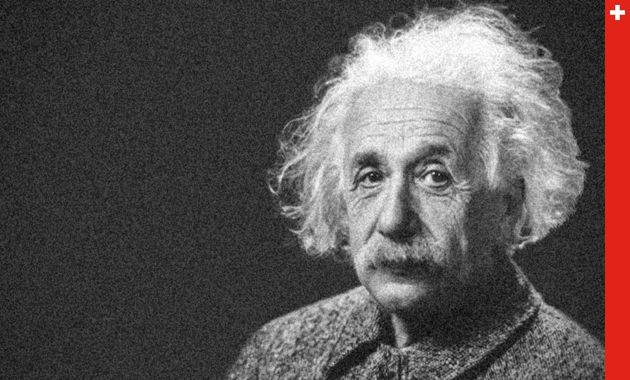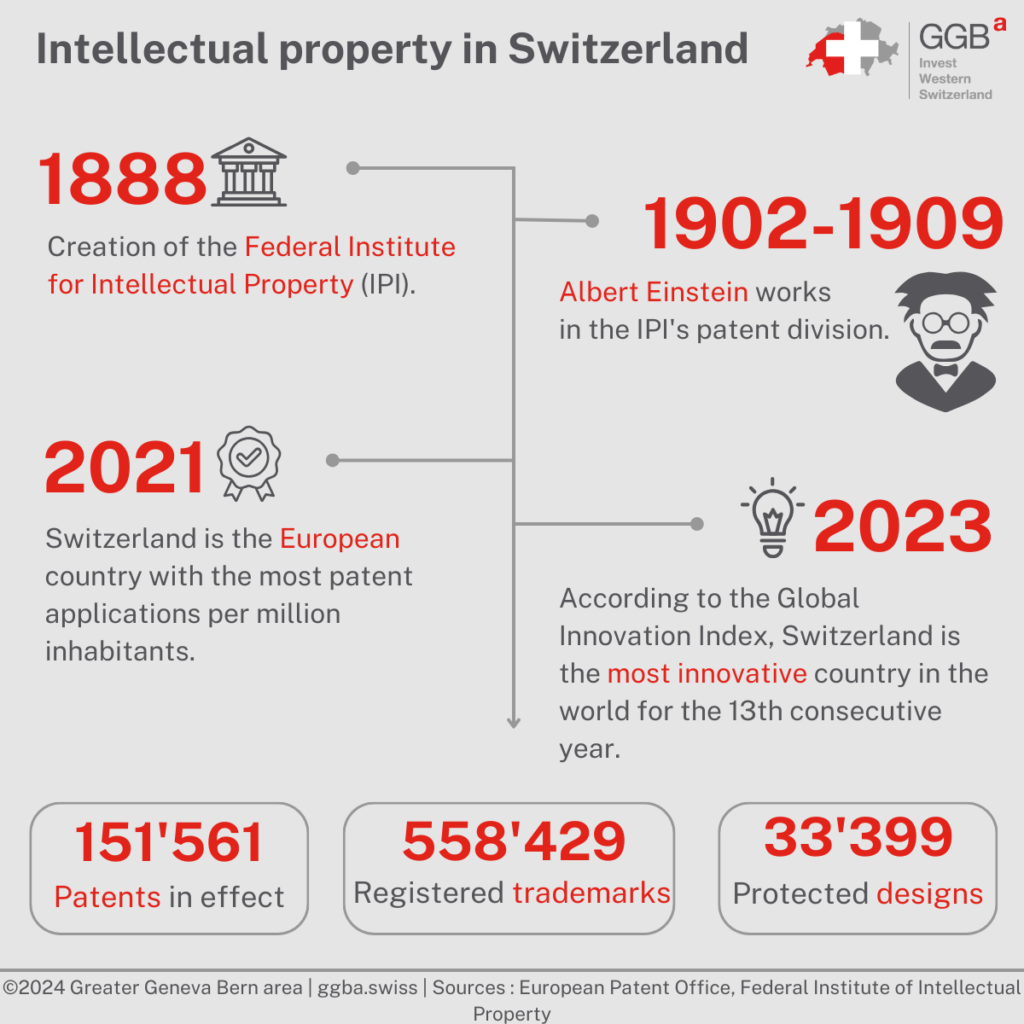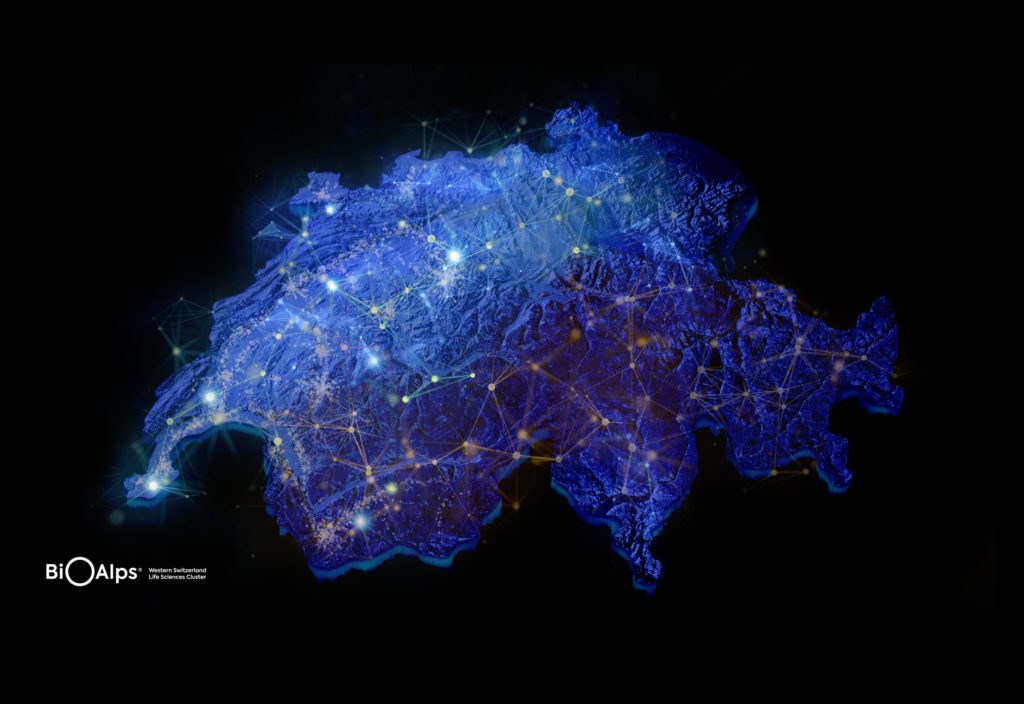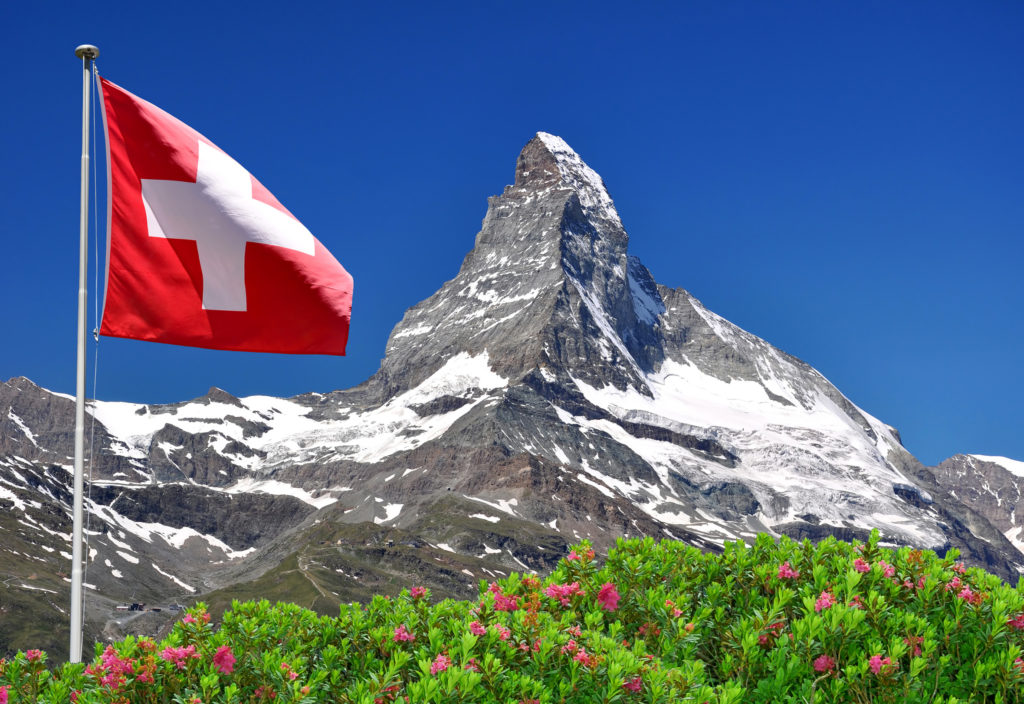
Intellectual property protection in Switzerland

The protection of intellectual property rights is a central issue for the Swiss authorities. Indeed, Switzerland being the most innovative country in the world according to the Global Innovation Index, it is essential to ensure a solid and meticulous intellectual property protection system.
The Swiss Federal Institute of Intellectual Property (IPI) is the federal government’s center of competence in Switzerland for all issues concerning patents, trademark protection, indications of source, design protection, and copyright. Individuals and companies register their innovations and creations to protect themselves against copying. The IPI also offers training courses on how to recognize the potential of a trademark, patent, or design and helps to implement a protection strategy. In addition, it is possible to access all Swiss intellectual property or national applications for registration through the Swissreg database administered by the IPI.
It should be noted that the protection of Swiss innovative products and services is not limited to Swiss territory. Indeed, thanks to the numerous bilateral agreements between Switzerland and its trading partners and its membership in the World Intellectual Property Organization (WIPO), it is possible to enforce the protection of one’s intellectual property beyond the Swiss border, as we will see further in this article.
To adequately protect your invention or creation, it is important to understand the differences between patent, trademark, design, and copyright protection.

Patents
A patent is a title that allows to protect a technical invention and prevents third parties from using this invention for industrial purposes for a maximum period of 20 years, provided that the annual fees or annuities are paid every year after four years from the date of application. Any natural or legal person can apply for a patent for an invention. However, the inventor is always a natural person and is named as the inventor on the patent application. A patent costs CHF 200 for the application, CHF 500 for the patent search in Switzerland, and CHF 500 for the patent check.
Thanks to patent rights, it is then possible to determine who can manufacture one’s technical invention, sell it or import it in countries where one holds a valid patent. These rights can therefore provide a real competitive advantage in case of the invention’s direct exploitation. However, it is necessary to pay attention to the waiting period: in Switzerland, it takes an average of three to five years between the filing of a national application and the granting of the patent. Upon request, an accelerated procedure can be applied.
To be eligible for a patent, the invention must fulfill three basic criteria:
- It must be a technical invention: it solves a technical problem by technical means.
- It must be new: an invention is considered novel if it is not in the public domain at the time of the patent application. It must not be a simple modification of an existing device. It must also be ingenious, that is to say not obvious to an expert in the field.
- It must have industrial applicability: it must be commercially usable, actually realizable and repeatable.
There are three ways to file a patent:
- National / Swiss patent: patent applications can be submitted to the IPI. Swiss patents are protected not only in Switzerland but also in the Principality of Liechtenstein. To apply for a national patent, click here.
- Regional / European patent: patent applications can be submitted to the European Patent Convention (EPC). A standardized investigation is then conducted by the European Patent Office, which is also responsible for granting the patent. Once granted, the patent is protected in the member states of the EPC, including Switzerland. To apply for a European patent, click here.
- International Patent: Patent applications can be submitted to WIPO under the Patent Cooperation Treaty (PCT). Ratified by Switzerland, it allows inventors to submit an international application which then has the same effect as a national application in all named member states. To apply for an international patent registration, click here.
Brands
In Switzerland, any term, slogan, or symbol used to distinguish the goods and/or services of one person from those of another (natural or legal) is considered a patentable trademark. Trademarks are therefore considered as commercial identifiers.
In order to be registered as a trademark, the term, slogan or symbol must meet the following criteria:
- The trademark must not infringe on the rights of third parties (for example in the case of an already registered trademark).
- The mark must be distinctive.
- The mark must not describe the goods or services concerned.
- The mark must not offend public order or public morality.
Natural or legal persons can apply for a trademark registration at Swissreg. A trademark remains registered for 10 years from the date of application, and the registration can be maintained indefinitely by renewals at 10-year intervals. However, it should be noted that Swissreg does not check whether an identical or similar trademark already exists. It is therefore recommended to perform an availability analysis of the trademark with a trademark lawyer before applying. Unlike patents, the registration process is relatively quick: if the trademark meets the requirements for protection, it is normally registered within a maximum of six months. The registration fee is CHF 550.
There are three ways to register a trademark:
- National Registration: Trademark applications can be submitted to the appropriate national intellectual property authority and must meet local legal requirements. To apply for national trademark registration, click here.
- Regional / European registration: Trademark applications can be submitted to the European Union Office for Intellectual Property via a single application. The trademark is then registered and protected in all EU Member States. To apply for European trademark registration, click here.
- International registration: Trademark applications can be submitted to WIPO. Under the Madrid System, the trademark owner can register the trademark in any of the member states via a single application. The application is then evaluated by the various national trademark registration authorities. To apply for international trademark registration, click here.
Designs
A design or pattern refers to the visual appearance of industrially produced items. It can be two-dimensional (for example the pattern of a fabric or the label of a bottle) or three-dimensional (for example in the case of a watch, a table or a lamp).
To be protected, a design must meet the following criteria:
- It must be new.
- It must be original, that is to say it must be sufficiently differentiable from existing designs.
A design can be protected for a maximum of 25 years, provided that the renewal fees – which amount to CHF 200 – are paid every 5 years. As with trademarks, the IPI does not check whether an identical or similar design already exists. Before filing an application, it is therefore recommended to perform an availability analysis of the design, either directly or with the help of a specialized attorney.
There are three ways to protect designs:
- National registration: design registrations can be submitted to the relevant national intellectual property authority and must meet local legal requirements. To apply for national design registration, click here.
- Regional/European registration: design applications can be submitted to the European Union Intellectual Property Office via a single application. The design is then registered and protected in all EU Member States. To apply for European design registration, click here.
- International registration: design applications can be submitted to WIPO. Under the Hague System, the design’s owner can register it with one of the 73 contracting organizations located in 90 countries (including Switzerland) via a single application. The application is then evaluated by the various national design registration authorities. To apply for international design registration, click here.
Copyright
Copyright protects the author of literary and artistic works. It arises automatically upon the creation of such a work and does not require registration. It applies during the author’s life, plus a maximum of 70 years. The first owner of the copyright is the author himself; however, if he creates the work in the course of his duties, the first owner is the employer.
In a nutshell: the protection of intellectual property is legislated in Switzerland by the Federal Institute of Intellectual Property. Thanks to the latter, it is possible for any individual or legal entity to protect their innovation within a defined legal framework, and to be accompanied in a process that is sometimes complex.
Greater Geneva Bern area (GGBa) is the investment promotion agency of Western Switzerland. If you would like to know more about intellectual property protection in Switzerland or about other subjects that could help you in your implantation, do not hesitate to contact us.
Our “Why Switzerland” articles can answer your questions.

